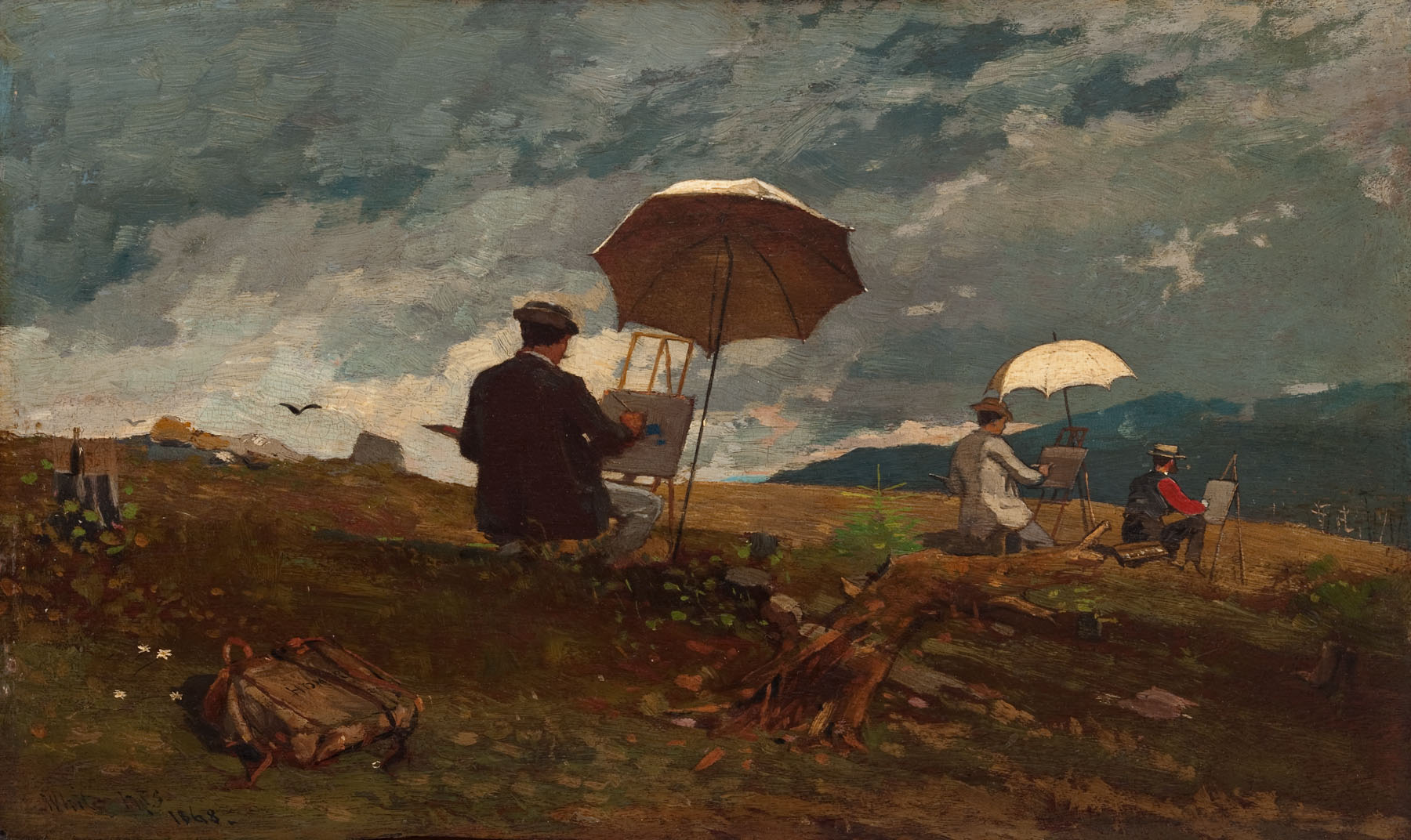I will frankly admit that much of what I love about Winslow Homer is his preoccupation with everything I love about the New England coast. His "mature" period as a painter was spent in Maine, and most of his famous ocean scenes date from that time. But beyond the sympathies born of a common heritage and a common love for what is arguably one of the most unconquered portions of the natural world, there is much else about Homer's work that I find fascinating.
You have first his early French period, during which he drew on Millet's scenes of country life and was encouraged in his already-remarkable use of natural light by the example of the impressionists.
Above: "Artists Sketching in the White Mountains," 1868.
Compare the lighting in the above to that in Millet's Gleaners, though there are few other similarities between the two paintings. Homer's earliest American paintings tended to focus on the middle class who would have been the type to want themselves in a painting, in stark contrast to Millet's work (out of a natural enough desire to have sell-able paintings. Once he changed his subject matter, sadly, he hardly sold anything.) The French painter did, however, provide the inspiration for Homer's next major development; during Homer's Maine period, he built upon Millet's tendency to depict people who were less obviously "self-conscious", or at least less conscious of posing for a picture. Like Millet, he refused to sentimentalize his subjects, giving them a heroic dignity through his recognition of their struggles (think of Catherine the Great's bowdlerized trip through Russian peasant villages for an appropriate contrast). Not like we're talking about a socialist disposition in either painter; respect for hard work, rather, and even awe at the daring of man facing off against nature. Exactly what you see in this picture:
An interesting one (and famous), and a good (if extreme) example of the above-described struggle, though not one I'm all that fond of, since it's far more Romantic than the average Winslow Homer painting. A tad Sturm und Drang, one might say, given the setting. But it bucks that label, and retains my respect, through the odd choice of depicting the sailor as so remarkably impassive. There's none at all of the romantic hero's angst to be seen here. No wailing about the state of the world or the cruelty of Nature/Fate. There are sharks, a water spout, and a ship on the horizon, but this man is just lying there without reacting to any of them. There's a certain selflessness involved in working with nature, in inherently dangerous conditions, and that's precisely what you see in this man's reaction (and throughout Homer's paintings, really). There's not much he can do about his situation, now he's there, and he seems completely resigned to the fact. He certainly doesn't seem offended by his fate, nor particularly interested in evading it. A recognition of the natural order of things: man can do a lot that he perhaps shouldn't be able to do, given his rather puny stature in comparison with nature, but the latter can run roughshod over us whenever we push past the comfortable confines of the town on shore and dare to venture out there.
Homer has one rather amusing quote about this painting, actually, given in response to a request for the " narrative" of the painting: "I regret very much that I have painted a picture that requires any description....I have crossed the Gulf Stream ten times & I should know something about it. The boat & sharks are outside matters of very little consequence. They have been blown out to sea by a hurricane. You can tell these ladies that the unfortunate negro who now is so dazed & parboiled, will be rescued & returned to his friends and home, & ever after live happily." Very nice.
And while we're at it, here's my favorite Winslow Homer of all: "The Fox Hunt", 1893. A late painting, and an even darker one than the last. Starving ravens descending upon a fox. One can also see some influence of the Japanese three-paneled design here, as well as Homer's late (and depressing) version of Darwinism.
Another amusing anecdote: Homer showed Elbridge Oliver, the Scarborough, Maine stationmaster, the first version of this painting and asked his opinion. The stationmaster responded "Hell, Win, them ain't crows"... Homer and Oliver proceeded to observe crows descending on scattered bits of corn, and Homer revised his painting according to Oliver's advice.



No comments:
Post a Comment